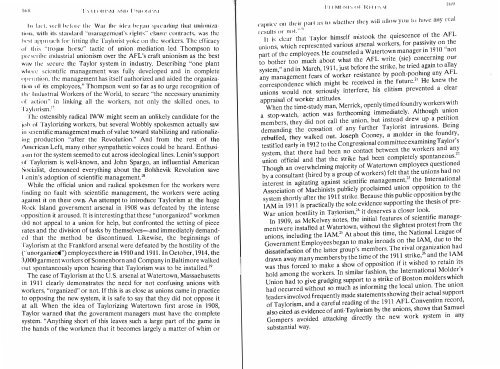CONTENTS - ouroboros ponderosa
CONTENTS - ouroboros ponderosa
CONTENTS - ouroboros ponderosa
Create successful ePaper yourself
Turn your PDF publications into a flip-book with our unique Google optimized e-Paper software.
If, ; ' / , \YI(H\ I.',I\I ;\ NI I I INII Jr'I J',1\1<br />
III 1;t·1. vdl hdi.uc Ihl· Waf Ihl' ide;1 hq'.;l1 1 .... IHcadillg Ihal IIl1ioniza -<br />
.<br />
11011, wll h lis sl;IIHtlrd "l1lallagcmelll's rights " clause contrt.lcts, was (he<br />
h('sl ".1 'I" """.', I(H' fi tting the Taylorist yoke on th" workers. The efficacy<br />
,If IIHs "trojall horse" tactic of union mediation led Thompson to<br />
IH" "'nhc lIldustrial unionism over the AFL's craft unionism as the best<br />
wav I he secur the Taylor system in industry. Describing "one plant<br />
wh('l"c . sCIentific management was fully developed and in complete<br />
' I '('I""tlon, the management has itself authorized and aided the organiza<br />
I II HI 01 Its employees," Thompson went so far as to urge recognition of<br />
I iI,' IlIdus n 1 Workers of the World, to secure "the necessary unanimity<br />
<br />
" I "dlllll<br />
,<br />
m hnkmg all the workers, not only the skilled ones , to<br />
'I';lylorism.17<br />
The ostensibly radical IWW might seem an unlikely candidate for the<br />
,Ph ()f Taylorizing workers, but several Wobbly spokesmen actually saw<br />
III sCIentIfic management much of value toward stabilizing and rationalizillg<br />
production "after the Revolution." And from the rest of the<br />
I\merican Lcft, many other sympathetic voices could be heard. Enthusi<br />
"SIl for the system seemed to cut across ideological lines. Lenin's support<br />
01 r ayloflsm IS well-known, and John Spargo, an influential American<br />
Socialist, denounced everything about the Bolshevik Revolution save<br />
J ,cnin's adoption of scientific management. 18<br />
While the official union and radical spokesmen for the workers were<br />
finding no fault with scientific management, the workers were acting<br />
agamst It on their own. An attempt to introduce Taylorism at the hugc<br />
Rock Island government arsenal in 1908 was defeated by the intensc<br />
OpposItIon It aroused. It is interesting that these "unorganized" workmen<br />
did not appeal to a union for help, but confronted the setting of piece<br />
rates and the division of tasks by themselves-and immediatcly demand<br />
."," that the method be discontinued. Likewise, the beginnings of<br />
I ayloflsm at the Frankford arsenal were defeated by the hostility of the<br />
(" unorganized") employees there in 1910 and 1911. In October, 1914, the<br />
3,000 garment workers of Sonnenborn and Company in Baltimore walked<br />
out spontaneously upon hearing that Taylorism was to be installed. '.<br />
. The case of Taylorism at the U.S. arsenal at Watertown, Massachusetts<br />
111 191 1 clearly demonstrates the need for not confusing unions with<br />
workers, . "organized" or not. If this is as close as unions came in practice<br />
to Opposmg the new system, it is safe to say that they did not oppose it<br />
at aU. When the idea of Taylorizing Watertown first arose in 1908<br />
Taylor warned that the government managers must have the complet<br />
system. "Anything short of this leaves such a large part of the game in<br />
the hands of the workmen that it becomes largely a matter of whim or<br />
1;1 1 MI 'NI\ tl\' 1{1'1 1 1":\1<br />
capricc Oil their pari as 10 whether Ihey will allow you Il) have any real<br />
results or not. ".'1)<br />
I t is ciL:ar that Taylor himself mistook the quiescence of the AFL<br />
unions, which represented various arsenal workers, for passivity on the<br />
part of the employees. He counseled a Watertown manager in 1910 "not<br />
to bother too much about what the AFL write (sic) concerning our<br />
system," and in March, 191 1, just before the strike, he tried again to allay<br />
any management fears of worker resistance by pooh-poohmg any AFL<br />
correspondence which might be received in the future.21 He knew the<br />
unions would not seriously interfere; his elitism prevented a clear<br />
appraisal of worker attitudes.<br />
When the time-study man, Merrick, openly timed foundry workers WIth<br />
a stop-watch, action was fo rthcoming immediately. Although union<br />
members, they did not call the union, but instead drew up a petItion<br />
demanding the cessation of any further Taylorist intrusions. Bemg<br />
rebuffed, they walked out. Joseph Cooney, a molder in the fo undry,<br />
testitled early in 1912 to the Congressional committee examining Taylor's<br />
system that there had been no contact between the workers and any<br />
,<br />
union official and that the strike had been completely spontaneous.<br />
Though an overwhelming majority of Watertown employees questioned<br />
by a consultant (hired by a group of workers) felt that the unions had no<br />
interest in agitating against scientific management, " the International<br />
Association of Machinists publicly proclaimed union oppOSition to the<br />
system shortly after the 1911 strike. Because this public opposition by the<br />
lAM in 191 1 is practically the solc evidence supporting the thesis of pre<br />
War union hostility in Taylorism," it deserves a closer look.<br />
In 1909, as McKelvey notes, the initial features of scientific manage<br />
mentwere installed at Watertown, without the slightest protest from the<br />
unions, including the IAM. 25 At about this time, the National League of<br />
Government Employees began to make inroads on the lAM, due to the<br />
dissatisfaction of the latter group's members. The rival organization had<br />
drawn away many members by the time of the 1911 strike, " and the . IAM<br />
was thus forced to make a show of opposition if it wished to retam Its<br />
hold among the workers. In similar fashion, the International Moldr's<br />
Union had to give grudging support to a strike of Boston molders WhICh<br />
had occurred without so much as informing the local union. The union<br />
leaders involved frequently made statements showing their actual support<br />
of Taylorism, and a careful reading of the 1911 AFL Convention record,<br />
also cited as evidence of anti-Taylorism by the unions, shows that Samuel<br />
Gompers avoided attacking directly the new work system in any<br />
substantial way.<br />
.<br />
n






